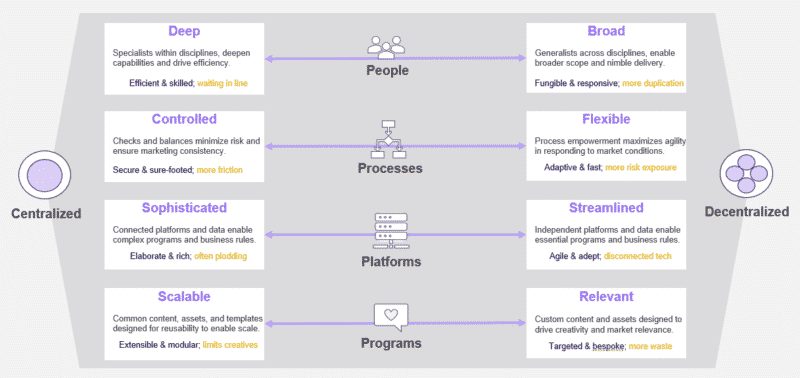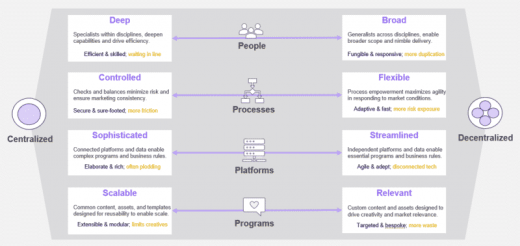Driving marketing at scale: People, processes, platforms and programs
Expect to make trade-offs between these four key elements of the new model.
The first part of this two part article considered reasons a business might move from decentralized, rapid response marketing to a more mature centralized (or hybrid) model. This second part looks at how to make the move.
The reality is nuanced, as you must consider needs and tradeoffs across all elements (people, processes, platforms, and programs) when shaping your model. Each element has opposing attributes that pull against each other in constant tension; changing your approach on any element (e.g. people) will positively and negatively impact the other three elements.
Unfortunately, many marketing execs stumble here, insisting on having all the positive benefits of a model with none of the downsides. You can’t have your cake and eat it too, and as the Dread Pirate Roberts says, “anyone who says differently is selling something.” But there are ways to nibble at the edges.

People: Deep vs broad
Your broad people approach is experiencing growing pains and needs to scale. While it would be incredible to have a team of copywriters who code HTML, do mockups in Figma, manipulate data in Python, and are whizzes at Google Analytics, those unicorns only exist in CMO fantasies. People are usually deep or broad in their skills, but rarely both.
The tradeoffs
A “broad” people approach relies on generalists who handle a variety of tasks with agility and flexibility. This decentralized model is adaptable and responsive, enabling teams to capitalize on shifting market conditions. On the flip side, broad approach can suffer from redundancy and waste as generalists create duplicate solutions. Compliance and governance are also harder to enforce across a more distributed workforce.
A “deep” people approach relies on specialists who are experts in a domain. Operating with efficiency and proficiency, this centralized model can unlock additional platform capability or help enforce governance by more easily enabling checks and balances; it enables more sophisticated programs to capture.
Implications of moving from broad to deep
How can you retain the benefits of a broad people model while deepening your expertise? Hybrid models offer a balance where some functions are centralized (e.g. marketing operations, content creation, strategy) in support of distributed functions (e.g. marketing execution, event management, social) to capture the best of both worlds. In these models, centralized teams do the heavy lifting, while decentralized teams focus on last-mile customization and delivery.
If it consistently takes a specialist longer to explain how to do the work than it does to do it, the specialist performs the work. In contrast, if it consistently takes a generalist longer to fill out a request intake form than it would to perform the work, the generalist performs the work.
When considering what to centralize or decentralize, tasks that are simple and easily transferrable are best done by generalists (e.g. making an update to a blog post) while more complex tasks are performed by specialists (e.g. coding up a new blog template). Don’t burden generalists with tasks beyond their skills and don’t give specialists tasks beneath their skills. Getting the right tasks into the right hands gives you the best chance for success.
Processes: Controlled vs flexible
As a decentralized approach, the whatever it takes to get stuff done (WITTGSD) approach has its time and place helping you capitalize on fast and furious opportunities without pausing to create the perfect process while a competitor zooms ahead. But your continued growth brings risk that must be purposefully managed. While amazing for facilitating early, rapid expansion, it’s difficult for hyper-flexible processes to deliver consistent and compliant outcomes.
The Tradeoffs
A “flexible” approach empowers marketers across the organization to set process as needed to achieve outcomes. This decentralized, method is incredibly useful during early, rapid growth giving marketers autonomy to mold process around quickly changing needs. This allows the business to breath, giving it room to grow without too many restrictions. If not managed carefully, the flexibility can give way to compliance gaps, inefficient delivery, and inconsistent programs.
A “controlled,” centralized process approach uses checks and balances to ensure tight consistency and compliance throughout the marketing lifecycle. This method may use a structured, end-to-end marketing process complete with necessary pre-launch approvals from subject matter experts in privacy, data security, or brand. Be aware that a more controlled process will enable standards to be enforced but also introduces friction which slows bringing programs to market.
Implications of moving from flexible to controlled
What’s the best way to achieve more control without over-restricting flexibility? Having tighter governance but still giving room to maneuver?
Your marketers only have so much “share of mind” that can be occupied by governance and process. When mistakes happen, things start to slow down, or people skip important steps, these are signs you are struggling to self-manage and it’s only a matter of time before it bites you. Governance can be overseen by a person or team of experts who review work prior to delivery. These experts may specialize in anything from privacy and data security, brand adherence, or correct campaign tagging. By unburdening front-line marketers from these governance responsibilities, you free them up to fully focus on their superpowers. If you can’t afford a headcount for governance, have someone trained to do it as part of their current role.
To mitigate the slowdowns that come from relying on others, consider marketing-oriented workflow solutions (Workfront, Wrike, Jira, etc.) to digitize and orchestrate your end-to-end process. These tools digitize your marketing supply chain while enabling a balance between speed and compliance. They track projects at all points in their lifecycle, manage and trigger approvals, and keep teams on the same page. As a marketing “system of record” they can serve as the institutional memory regarding process and governance, freeing up everyone to focus on what they do best.
It’s also okay to decide where you need more process control and where you are ok with less (e.g. privacy and data security versus brand guidelines and campaign tagging). Consistent brand representation and reporting is important, but honoring privacy preferences and securing customer data is critical.
Enforcing a standard, end-to-end marketing process will be slower at first but will prove much faster with time. When establishing process discipline, be forewarned people will speak of the WITTGSD “glory days” when requests were delivered in five minutes. Selfishly these individuals myopically see their small piece of a growingly complex marketing supply chain. WITTGSD was faster in the early days, but it’s inability to scale will crater your agility and become less compliant with time, putting all marketing at risk.
Platforms: Sophisticated vs streamlined
Despite what all SaaS vendors will tell you, marketing platforms cannot be both thoroughly sophisticated and simple-to-use. While today’s martech allows mere mortals to perform tasks once the domain of only the most technical, tools don’t stand still, begetting richer features and connecting with other tools in a growing cycle of complexity. Any capability worth its salt is rarely “walk-up-and-use” friendly beyond simple use cases, rather it takes longer to master and requires dedicated martech specialists.
The tradeoffs
A “streamlined” platform approach relies on essential capabilities, lightly connected, that use simple rules and intelligence to execute programs. This decentralized model has minimal tech debt, uses out-of-the-box capabilities where possible (avoiding code), and enables basic marketing programs. The streamlined approach enables agility and flexibility, and its simpler structure empowers generalists to do most of the work. While responsive, streamlined platforms produce more basic programs that are not as interconnected, leaving market opportunity on the table only more sophisticated programs and specialists will capture.
A “sophisticated” platform approach is rich, interconnected, and employs complex business rules and intelligence to enable powerful marketing programs. This centralized approach boasts massive efficiency through highly automated and scalable marketing, requiring specialists to effectively operate the ecosystem of capabilities. Its interconnected nature allows for rich programs where customers and prospects seamlessly move across channels as they interact with content. While these platforms are powerful, modifying the ecosystem is like turning a cruise ship; once turned it’s a party, but the process leaves marketers exhausted and frustrated.
Implications of moving from streamlined to sophisticated
As a fast growth company, whether your marketing tech is sophisticated or not, you’re likely leveraging core functionality to enable delivery. With continued rapid growth on the horizon, do you need to unlock more sophisticated capabilities or purchase additional tools? Or are your current platforms sufficient?
When deciding on your platform approach, ask yourself if “the juice is worth the squeeze” to enable your programs. A VP of Marketing I worked for always wanted the organic, freshly squeezed orange juice of sophisticated marketing programs, requiring deep platform expertise. Where most of our audiences were happy with frozen OJ concentrate from a can, making all the platform squeezing for premium juice unnecessary. While everyone loves a shiny new SaaS tool or sexy feature, adding more sophistication adds power but also adds complexity and debt. Make sure the value is there before investing.
A hybrid model can walk the tightrope between streamlined and sophisticated. With advances in the marketing SaaS world, tools easier to snap together than ever with APIs and out-of-the-box connections. By using a “configure over code” approach wherever possible you can enable a balance of flexibility and sophistication that minimizes tech debt. Use custom code when the use case is high enough ROI and not well covered by existing features or tools. As you become more sophisticated, establish a formal marketing operations function if not already in place or at least use professional services to act as the specialists to complement your on-staff generalists.
Final thought: Don’t get too hung up on having the most sophisticated tech, rather emphasize getting more out of your existing stack. CMOs report 42% of the benefits of their current martech goes unrealized, so it’s a good starting point.
Programs: Scalable vs relevant
A constant tension exists between scale and relevance, and marketing leaders must ask at what point relevance must give way to scale. While “good enough” programs rarely win awards, they may be sufficient to draw in prospects and keep them as customers, doing so at a much larger scale.
The Tradeoffs
A “relevant” program approach is highly customized content to reach an audience or geography based on their unique needs. The most relevant programs maximize the impact of marketing and win the hearts of customers and prospects. In this decentralized model, program strategists may start with a “blank canvas” where the creative limits are their imaginations rather than technology. This allows maximum flexibility to build relevancy into programs and capture demand. While such freedom is liberating, bespoke programs can be prohibitively expensive to produce at scale and must be deployed judiciously.
A “scalable” program approach is highly modular, relies on reusable templates and components, and employs more complex business rules to enable efficient delivery. Differing from a blank canvas, this centralized approach enables flexibility within constraints, striking a balance between relevance and scalability. It relies on martech capabilities to assemble and automate repeatable programs which (once programmed) require limited oversight during execution. While robust, scalable programs can constrain the creativity of program strategists and lack relevance needed to capture some premium or niche markets.
Implications of moving from relevant to scalable
Your program approach to this point focused more on quickly getting content to market that resonates with your target audiences. The trick now is retaining the relevance you know is important while scaling it effectively and economically. “Scalable relevance” is achieved by moving toward a Lego mindset that emphasizes reusable templates, modules, and inter-changeable components that enable a “build once, use many” structure. Differing from the blank canvas, “build once, use few” approach, a Lego mindset embraces modern martech to enable data triggers which power targeted, real-time content. This method allows a custom collection of content components to come together in a digital experience targeting audience pain points. While not perfectly relevant, “scalable relevance” can reach a greater number of customer and prospects with highly resonating content at a fraction of the expense.
For this more centralized approach to work, greater emphasis on martech and data capabilities are needed. Aggregating a single view of an audience across your company’s data sources (e.g. finance, sales, support, marketing, product, etc.) creates a rich data environment from which powerful triggers can be programmed. This requires skilled marketing operations specialists who can move beyond simple martech use-cases to source data, program triggers, and build scale.
While it sounds overwhelming, most martech solutions have powerful capabilities to scale that don’t require fat stacks of cash. If strapped for cash, hire professional services to enable a few key programs and let the results make your next business case. While working at Expedia, we set up our first triggered program in 6 weeks with help from professional services at a modest cost. The efficiency savings and revenue benefits gave us a good enough story to tell execs that allowed us to more fully fund our martech team and stack.
Assess your Marketing Model
For creative marketing leaders, it’s hard to focus on the operational aspects of marketing, especially when you’re growing fast. You know what brought you early success needs an upgrade to capture the next wave of growth.
Rather than learn your way through this critical transition, take this complimentary 10-min Marketing Model Assessment to pinpoint elements needing attention based on your growth needs, giving you a simple side-by-side view of your current and desired state.
When considering changes, keep the firm’s goal to grow revenue faster than cost top of mind. Optimize your model for scale to “future proof” your marketing organization and keep pace with growth.
With thoughtful changes, you’ll mature from those awkward corporate teenage years into early adulthood. Heck, maybe you’ll even move out of your parent’s basement.  The future is bright.
The future is bright.
The post Driving marketing at scale: People, processes, platforms and programs appeared first on MarTech.
(17)



